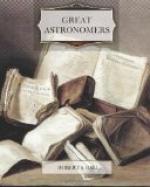[Plate: John Couch Adams.]
As we have seen in the preceding chapter, Le Verrier had been also investigating the same problem. The place which Le Verrier assigned to the hypothetical disturbing planet for the beginning of the year 1847, was within a degree of that to which Adams’s computations pointed, and which he had communicated to the Astronomer Royal seven months before Le Verrier’s work appeared. On July the 29th, 1846, Professor Challis commenced to search for the unknown object with the Northumberland telescope belonging to the Cambridge Observatory. He confined his attention to a limited region in the heavens, extending around that point to which Mr. Adams’ calculations pointed. The relative places of all the stars, or rather star-like objects within this area, were to be carefully measured. When the same observations were repeated a week or two later, then the distances of the several pairs of stars from each other would be found unaltered, but any planet which happened to lie among the objects measured would disclose its existence by the alterations in distance due to its motion in the interval. This method of search, though no doubt it must ultimately have proved successful, was necessarily a very tedious one, but to Professor Challis, unfortunately, no other method was available. Thus it happened that, though Challis commenced his search at Cambridge two months earlier than Galle at Berlin, yet, as we have already explained, the possession of accurate star-maps by Dr. Galle enabled him to discover the planet on the very first night that he looked for it.
The rival claims of Adams and Le Verrier to the discovery of Neptune, or rather, we should say, the claims put forward by their respective champions, for neither of the illustrious investigators themselves condescended to enter into the personal aspect of the question, need not be further discussed here. The main points of the controversy have been long since settled, and we cannot do better than quote the words of Sir John Herschel when he addressed the Royal Astronomical Society in 1848:—




